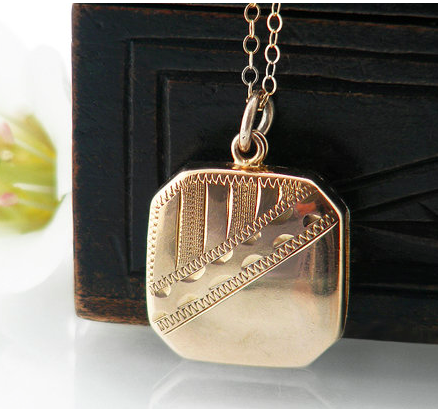Tis the season ladies and gentlemen. We have to cover our houses with tacky decorations, scroll past every single one of our friend's 'Elf on the Shelf' Facebook posts, and we need to give each other thoughtful gifts to prove our affections.
Antique and vintage objects are far more personal and possess far more soul than any mass produced object you're gonna snag off the rack at Old Navy, or Nordstroms, and often they're far more budget friendly as well. Here are some of my favorite antique-y gift ideas. I have given every single one of these as a gift in the past, cause I'm awesome like that, and now you can be too.
1. Candlesticks
Literally the only person for whom this is not an appropriate gift is your college attending cousin, who isn't allowed fire in her dorm. Everyone else likes fire; we're all pyros at heart, now's the time to elegantly say, "Here, now you can have classy fire, right at your dining table!". Candlesticks range in price. I've never been to the goodwill and not seen at least three sets, usually for under $5, often handsome mid 20th century brass or cut glass ones. Or you can shop antique stores or online for fancier versions. They come in all shapes and sizes so it's quite easy to pick a pair for your uptown modern sophisticated friend, and your friend who lives in a converted barn and lusts for the rustic. Up the ante by including a couple pairs of nice beeswax tapers in the package.
 |
| via |
 |
| via |
 |
| I especially adore this pair! via |
This is a TOP SHELF gift that costs soooooo little. Printed goods, ephemera, and maps are an outstanding and gorgeous gifty option. When I shop for a print to give as a gift I think about my target, what do they like? Do they have a hobby like golf, gardening, cooking, or crafting. Whatever that interest is, just climb up to that 'Ebay' search bar, and enter that interest "horses antique print" and you'll have mountains of options. Or maybe your friend has zero hobbies, but do they have a favorite vacation destination? Then enter "Florence antique map", or perhaps they love farmhouse decor, there's loads of fun 19th century prints of animals that look incredibly sharp when framed.
 |
| Here's a set of late 19th century prints that were originally book illustrations. How divine would they look framed and hung together! via via via |
 |
| For your New Yorker friend (we've all got one) here's a wonderful 1861 print of Central Park! via |
 |
| OR for the Fashionista, how bout an incredible set of original 1950s fashion prints from major fashion houses like Dior and Balenciaga. via |
Another category where you can get big impact for little investment. Silk scarves have been popular accessories for more than two centuries, though they really hit their stride in the second quarter of the 20th century. Because they're small, sweet, and easy to store, millions of them survive today in perfect condition. Since millions of them survive, they're quite affordable. As with prints, you can easily use a search term online to find a specific and personalized scarf, or visit a clothing consignment or thrift shop, where there's often cascading mountains of them, and put together a stunning color spectrum group of six or a dozen.
 |
| via |
 |
| via |
 |
| via |
Probably my personal favorite thing to collect, antique signs are handsome and intriguing and suit all decor from an urban industrial loft to a quaint cottage kitchen. Many are quite delightful and cheeky too! I found both these signs in about thirty seconds of searching ebay- under the "architectural and garden" category of the antiques tab. Auctions such as Garth's, Skinners, Cowan's, and Pook and Pook also have loads and loads of amazing authentic antique signage.
 |
| perfect for a man-cave. via |
 |
| I mean, come on, this is to die for!! via |
I hardly ever wear jewelry, but when I do, you're damn right it's antique stuff I bought for a song. It boggles the mind that anyone buys new jewelry when there's so many spectacular options to be found at every single antique store in the country. You can either purchase something elegant and refined, or give a funky set of costume baubles in crazy colors! For the dapper man there's an incredible array of antique cufflinks to be had.
 |
| I LOVE this early 20th century Art Deco gold locket it, BE STILL MY HEART This is what I want for Christmas! via |
 |
| Take no prisoners drop dead gorgeous via |
 |
| Sophisticated and delicate and perfect for the office or a night out via |
 |
| Antique cufflinks to add a bit of character to any gentleman's suit game via |
For a cozy, homey hostess gift, why not an antique mixing bowl! They come in all shapes, sizes, and colors to suit any kitchen, and are chunky, durable, functional, and endearing. Take the gift to the next level by filling it with yummy treats, or a cookie mix kit!
 |
| Deep blue add a healthy dash of color to any kitchen via |
 |
| The perfect popcorn bowl EVER! via |
 |
| Just picture this stunning pair on a shelf in a farmhouse kitchen! via |
The perfect gift for the bibliophile in your life, vintage and antique bookends usually cost $50 and under, are small, easy to ship, and will last a lifetime. There's bookends to meet every taste from reclining nudes to busts of Abraham Lincoln. They're simple to find at antique shops, thrift stores, and of course on ebay and etsy.
 |
| This solid brass Art Deco option is collapsible! How clever is that! Would be great in a kitchen to hold cookbooks. via |
 |
| I have a dear friend who has a Scottie, I bet she'd love these. via |
 |
| For the Harry Potter fan, the bird lover, or anyone who (rightly) thinks owls are super cool via |
There's a never-ending supply of nifty storage vessels out there in the world of antiques. I personally love a beautiful antique wood document box, but there's also tea caddies, trunks, tool chests, and sweet little sliding lid boxes. Everyone has something that would be better off cunningly stored away in a wonderful antique box. Perfect for recipes or playing cards, collections of wee small interesting things, or jewelry.
 |
| 19th century walnut document box. I'm reeaaaaally thinking about bidding on this one for myself. Love the taped in mirror. via |
 |
| Known as a "tantalus" this is the 19th century version of a mini bar, meant to hold bottles of booze and other drink-y accessories. Would be great with several bottles of fine liquor, or could make the perfect desk top accessory organizer via |
 |
| The stenciled numbers make it for me, SO CUTE. via |
And while we're on the topic of holiday "spirits" what's an easier gift than a stunning antique decanter! Fill it with booze, or package it up with a bottle of your giftee's drink of choice, or just leave it as is. Most thrift shops will have multiple options, many of which cost a small fortune when new and are now are $10 or under. Just a couple months ago I scored a flawless Bacarat crystal decanter at the goodwill for $4! You can also armchair shop from a pool of thousands on etsy and ebay.
 |
| The absurdly elongated stopper on this Georgian option is fabulous via |
 |
| The perfect pair! via |
 |
| And some wonderful silver detailing on this early 20th century option! via |


























